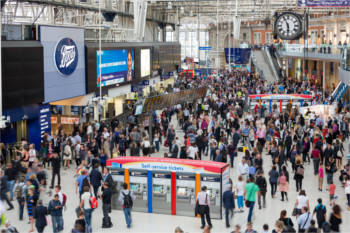Britain’s rail companies need to cope with a doubling in passenger numbers by 2030. For a rail network that already carries 40% more passenger journeys and 60% more freight than it did 10 years ago that is a significant challenge.
As Network Rail’s report Britain Relies on Rail bluntly pointed out: 'At peak times on the busiest parts of the network there is no space for more trains but demand for rail is still increasing.'

The wrong track? Has rail prioritised the customer experience?
There are plans underway to cope with this increase in demand. Infrastructure upgradesk, from headline-grabbers such as Crossrail and HS2, to the many lower profile projects such as the re-opening of the Airdrie-Bathgate line, the upgrade of the Felixstowe-Nuneaton line, and the expansion of the Northern Hub, will all help with the practicalities of moving people and goods from A to B.
Recent and planned station upgrades – such as the transformation of Reading station – together with investment in rolling stock will also play an important role.
However, there is more that can be done. Rail companies that invest now in understanding and improving their customer journey will significantly enhance their ability to cope with the additional pressures they will face in the coming decade.
This is the great untapped opportunity for the rail sector. Those companies that recognise it and act now will benefit from lower customer complaints, higher revenues, enhanced reputations, and ultimately a better chance at franchise renewal.
Learning from beyond rail
This is such unexplored territory that it is hard to point to any rail company already doing it as a best practice example. As a sector, rail has been so focussed on practical and technical issues that it has paid barely any interest to these softer aspects of brand, reputation and customer experience.
Yet a cursory glance at other sectors reveals the potential here. Walk into any Apple store and experience its customer journey. It enjoys unparalleled customer loyalty and profits, not because of any product superiority but because of its attention to the customer journey. Look at the trust felt for John Lewis. That has allowed it to thrive while the rest of the high street has dwindled or shut up shop. Again, not because of product, but because of customer experience.
Jeff Bezos has declared himself to be obsessed with the customer experience, and it was no surprise to see Amazon top this year’s Institute of Customer Service list of the top 50 best UK companies for customer service.
There was no rail company to be seen in that list, but that can be changed. It is not enough to wait for Network Rail for infrastructure upgrades. Forward-thinking rail companies can act now to upgrade their customer experience and become the Apple, John Lewis or Amazon of this sector.
Upgrading the customer journey
So, how to do it? The first step is to begin with a detailed mapping of the customer journey. Understand every single touchpoint that a customer has with your organisation, from information on scheduled arrivals and departures, to ticket booking and confirmation, to the station experience, and then the journey itself.
Within that journey there are hundreds, possibly thousands, of touchpoints, and for each rail company the experience for customers varies widely. Begin by understanding them, and then, armed with that knowledge, explore ways to improve them. Here are just three initial ideas to indicate the possibilities here. There are many more, but think how much you could improve your customer experience by investing in just these three areas.

Anger over delays is often the result of poor communication
1. Go mobile
Walk into a busy city terminus and you will see hundreds of people standing there looking at their phones trying to work out the best train to take, when it departs, which platforms to go from, and so on. It is a vivid illustration of how important mobile now is to the customer. Train companies can do much more to improve this aspect of the experience.
Apps can be better designed with more intuitive layouts. At airports phones now double as tickets, so why isn’t this happening at stations? Why are we still spending millions every year on print costs, as well as ticket machines and offices when it could all be put onto an app, making it simpler and easier for the customer?
Why does the app not alert customers when their train is pulling into their stations of departure and arrival? Why do we make announcements in trains and stations about delays but not alert passengers via the app? How many passengers have headphones on and so miss those announcements? Airline apps now alert passengers when gates open and warn them of anticipated delays, so the technology is there – it is time for train companies to start using it.
2. Be trusted
People love honest brands. They will forgive them a lot. Be straightforward and honest in what you promise, and then communicate quickly, openly and frankly around any shortfall in delivery and you will be respected and understood.
Rail companies underestimate the damage done by all those passengers standing on platforms wondering when their train will turn up. In many cases their anger and frustration is not a result of trains being late – people understand that there are often good reasons trains run late – it is more a result of the poor communication around it. That is what damages trust and starts to a spiral of negativity which leads to customer complaints, lost revenue, and ultimately franchise loss.
Similarly, last December’s 'super-complaint' to the Office of Rail and Road, by consumer group Which? about the difficulties delayed passengers have in claiming compensation, points to another way rail companies can build trust and enhance the customer experience.

Jake Mason
3. Improve stations
Finally, there are a host of ways the station experience can be improved. Many of those passengers frantically tapping on their smartphones would benefit from improved wayfinding around stations. All would welcome a boost to mobile signal.
Rail’s new necessity
None of this should be technology or change for its own sake - all improvements must be linked to the customer journey. But those initial ideas show just how much can be done to improve that journey. Perhaps most excitingly, in the context of the investment needed in infrastructure and equipment, these are improvements that are relatively inexpensive and quick to make.
The rail companies that take these bold steps and make those investments now will find themselves better able to cope with the increased pressures that will inevitably follow from a doubling of demand by 2030.
Network Rail’s report concluded that 'investment in rail is not a luxur
Register now for full access
Register just once to get unrestricted, real-time coverage of the issues and challenges facing UK transport and highways engineers.
Full website content includes the latest news, exclusive commentary from leading industry figures and detailed topical analysis of the highways, transportation, environment and place-shaping sectors.
Use the link below to register your details for full, free access.
Already a registered? Login